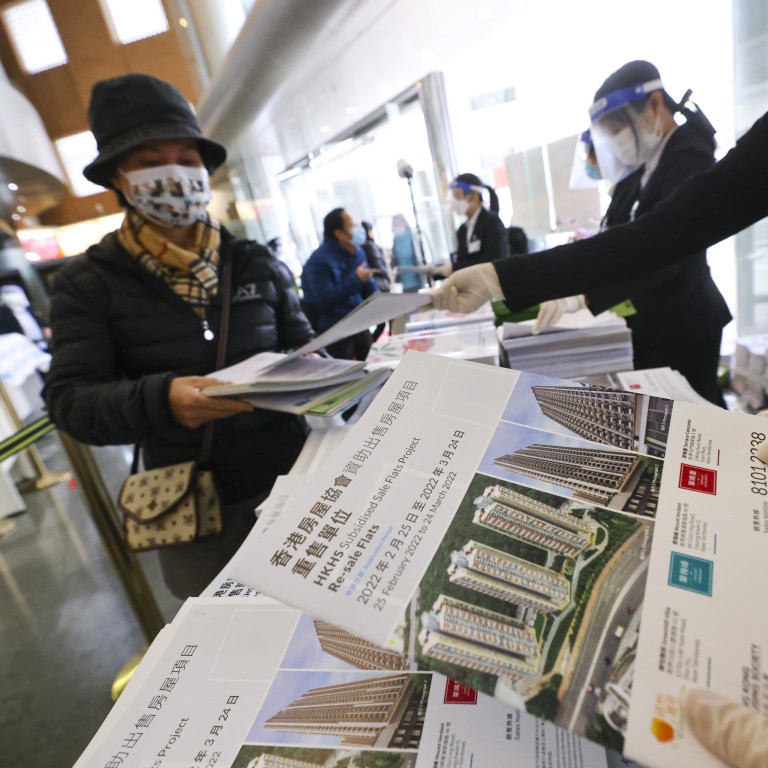
Aspiring Hong Kong homeowners rush to sign up for chance to buy shoebox flats the size of 1½ car park spaces
- The nano flats in Kai Tak are among the 8,926 homes of various sizes provided under this year’s Home Ownership Scheme
- Housing Authority says scheme has received a total of 17,000 online applications on its first day
Tiny government-subsidised flats as small as 186 sq ft have drawn the interest of aspiring homeowners in Hong Kong after applications launched on Friday, with some saying it was better to buy small than own nothing in the world’s most expensive property market.
The shoebox homes, located at the site of the former airport at Kai Tak, are among the 8,926 flats of various sizes offered as part of this year’s Home Ownership Scheme, targeting lower to middle-income households.
The Housing Authority said it received a total of 17,000 online applications on the first day of the scheme’s launch, in addition to accepting 100 forms and distributing 2,400 others at its sales centre in Lok Fu.
Amy Chow, 55, a former restaurant waitress, was among visitors to the centre on Friday morning. She said she was eager to own a place in an urban area, even if it meant a Kai Tak “nano” studio flat of just 186 sq ft, which is going for HK$1.59 million (US$203,850).
“It is so hard to have ‘a cosy nest’ in Hong Kong, although I have been working hard for so many years,” said Chow, who rents a flat in Sham Shui Po with her 22-year-old son.
Property owners, multinational firms face more taxes in Hong Kong
The former waitress said she hoped her son could shoulder the responsibility for paying the mortgage after he graduated from university in a few months.
The 2022 batch of flats will be located in seven mostly urban areas: Kai Tak, North Point, Ma Tau Kok, Kwun Tong, Tseung Kwan O, Sha Tin and Tung Chung.
Ranging in size from 186 sq ft to 479 sq ft, they will be sold at 49 per cent less than the market value, or between HK$1.24 million and HK$5.31 million. Buyers for the scheme, which is usually oversubscribed, will be chosen by a lucky draw.
Tse Yat-man, 42, a chef at a local restaurant who was also aiming for a slighter bigger flat in Kai Tak or on Anderson Road, Kwun Tong, said he had still wanted to buy a property despite the economic uncertainty created by the Covid-19 outbreak.

The chef, who lives with his wife and 13-year-old son, said he preferred a 300 sq ft flat in Kai Tak as he had a budget of less than HK$3.5 million.
“I am afraid of losing my job, but I will try my luck anyway, it is so hard to own a home in the city,” he said.
“It is understandable that they build small flats in the public sector due to the housing problem in Hong Kong.”
The Housing Authority introduced flats smaller than 30 sq m (322 sq ft) in 2018, with members having said that reducing flat sizes would be a way to quickly increase supply and ease the city’s housing shortage.
About 30 per cent of the new batch will be smaller than 322 sq ft. The 186 sq flats in Kai Tak, the equivalent of 1½ car park spaces, are the tiniest to be offered since the start of the Home Ownership Scheme in 1978.
While the government announced on Thursday that all private flats in the future would have to be at least 280 sq ft, unless in rare cases, there is currently no similar requirement for public housing.
‘Worse to come’ as Hong Kong home prices drop by most in two years
Andy Chan Kai-nok, a 35-year-old food shop owner, who said he aimed to own a flat in North Point, urged the Housing Authority to provide a greater supply of bigger flats.
Chan said would try his luck at getting the largest flat available at the project in Kei Wah Court, sized at 457 sq ft and valued at more than HK$5 million, but added that he had hoped for a 500 sq ft place for his family of four.
“The residents would feel more comfortable with a bigger home, which means they will be happier,” he said.


